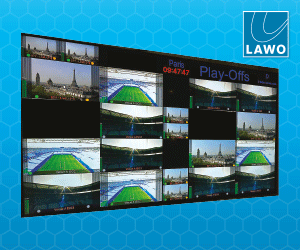There has been a huge impact on the world of video post-production for both professional end users and manufacturers alike thanks to the repercussions of the global economic recession and the parallel dramatic swing towards a more important role for freelancers. The simultaneous rise of an all-digital motion picture and episodic TV production workflow […]

There has been a huge impact on the world of video post-production for both professional end users and manufacturers alike thanks to the repercussions of the global economic recession and the parallel dramatic swing towards a more important role for freelancers. The simultaneous rise of an all-digital motion picture and episodic TV production workflow has also contributed to this growth. This trend has had a lasting impact on the kinds of equipment being used and purchased and the ways in which gear interact in the workflows. Some of this new direction predated the start of the global economic recession in that downsizing among post-production facilities and companies and later among TV stations got its start as far back as 2007, earlier than the general economic downturn.
In a recently published global research study, Video Post World 2012, from DIS Consulting, we note several trends.
The study, which was conducted this winter, gathered 1,316 responses from six vertical segments, worldwide including Broadcast/Cable, Production/Post/Mobile, Institutional, Independent & Freelance Video, Event Video and Rental Houses.
Downturn preceded recession
Even before the global recession arrived, video editing systems sales had already slowed substantially, compared with earlier in the 2000s. This was partly due to the rise of software-centric NLE solutions like Apples Final Cut Pro. Part was due to a virtual saturation in ownership of editing systems, generally, the result of the runaway success of the software based solutions. Then, along came the recession and tens of thousands of staff seats were eliminated, globally, and professional sites swung towards upgrading their existing systems rather than installing very many new ones. The net result of this phenomenon was a major slowdown for the editing systems manufacturers. That decline is now legendary and its impact was felt by all the manufacturers, but the four As (Apple, Avid, Adobe and Autodesk) in particular.
Simultaneously, graphics products, formerly a highly stand-alone or at least separately-processed solution set, have become much more software-centric and are quite often now seen as integrated partners in the same PCs or Macs as part of a comprehensive post system workflow, often in a multi-window configuration under the same, seat-by-seat approach. Many such software copies are residing in laptops, today, and that being driven by the vastly expanded freelance class.
The ranks of laptop-using freelancers expanded tremendously as inside staff were laid off during the recession from TV stations and production and post-production houses, and generally, throughout the industry. This actually fell quite heavily on news operations and as a result, resulted in greatly limiting equipment and software sales into news applications. While precise numbers are not available to size the numbers of freelancers, they have as a class of users expanded dramatically since the end of 2008, but its a trend that began even earlier in the late 2000s, as facilities cut back, due to lowered revenues.
The use of cloud computing technology has been another major trend shift in the post-production market. Storage has increasingly been transferred off into the cloud in opposition to building up huge internal storage infrastructures, the most popular of older methods. Meanwhile project collaborations have begun to routinely include the use of the cloud as a hub in an increasingly collaborative workflow and a frequently multi-national working structure. While there was a good deal of scepticism and distrust, initially, of using the cloud among broadcasters and media professionals, that seems to be diminishing as more and more are adopting cloud-based strategies.
At the same time, however, the market has seen the rise of connective devices, like those of BlackMagic, AJA and others. And, we have also seen the rise of workstations and/or the use of individual computers in which to load the numerous software elements of modern post-production. While this has been highly Mac-centric, it has not been exclusively so.
The impact on this workflow by the emergence of an all-digital, all-electronic motion picture production workflow has been palpable too. With the rise of 35mm cameras and camcorders, movie making has steered away from the use of film and rapidly become an entirely electronic and end-to-end post workflow. Supported by encoders and decoders and their related compression codecs, this workflow conversion has been able to seamlessly move recorded materials through the entire post process in a way faster and more dependable than in prior years.
Post trends in the Middle East and Africa
The pan-regional MEA experience has been fairly consistent regarding the overall trends described, except that the demand for post-production products has been stronger in keeping with seats being added in the region particularly within the expanding freelance segment and the newly expanding number of non-broadcast facilities seen as the growing arena of independent production and post-production houses and institutional video facilities which are very much in the ascendancy in the region.
The Arab Spring did throw a spanner into the works, interrupting normal activities, but it also built demand in places. In MEA, broadcast/cable post-production seats grew by 12%, production/postproduction/mobile by 8%, independent/freelance by 9%, institutional by 11%, event video by 4% and rental house by 2%, respectively. Understandably, the greatest growth has been seen in some of the biggest MEA media markets such as Saudi Arabia, the UAE and South Africa.
Conclusion
So, now global post-production operations tend to be synergistically combining both graphics and editing as well as layers of audio sweetening, colour grading and more into a comprehensive and attenuated workflow. Finishing projects on one platform or at one seat, or among shared and often equally configured seats, is also on the rise. Part of this impact has been caused by expansion of the use of stereographic 3D production and part by the anticipation of higher resolution and more immersive post driven by 4K and 8K capture and its impact on the post-production workflow. Could this be fueling a revival of the post-production products categories? Maybe not as much as a full-fledged revival, but certainly breathing some life back into
the space.
















































































